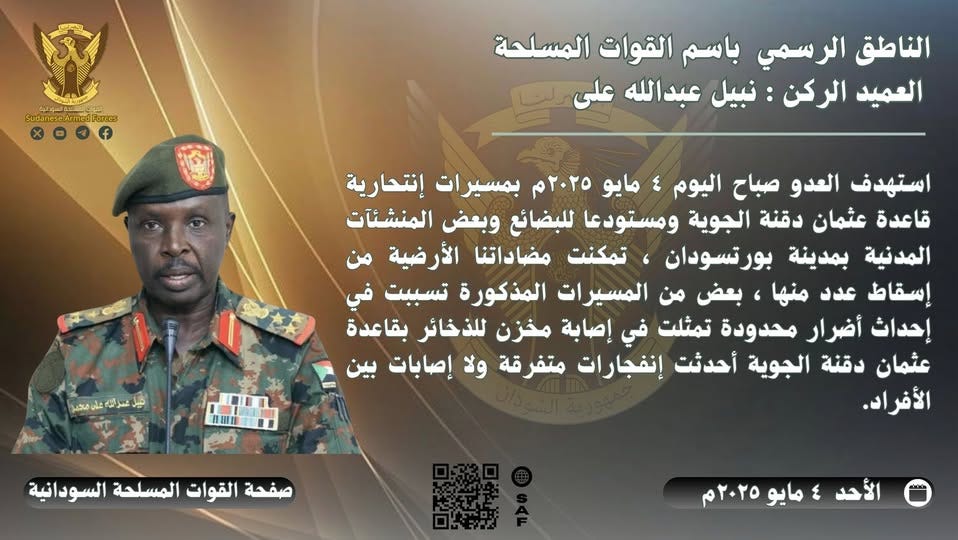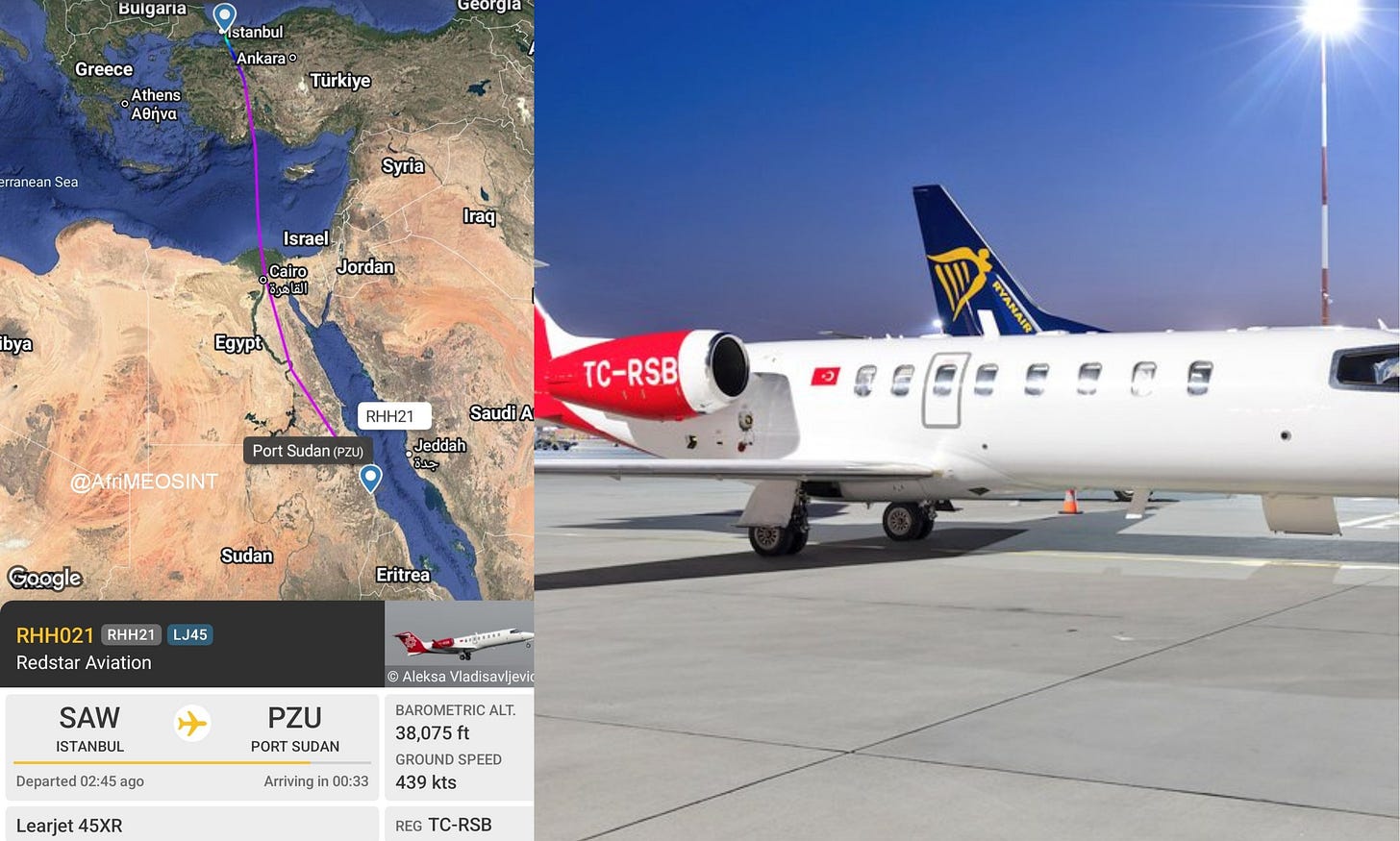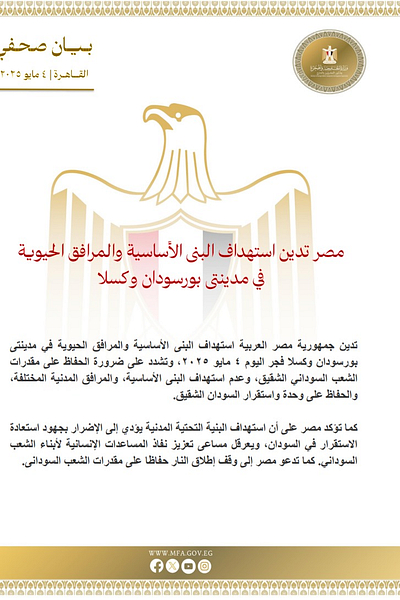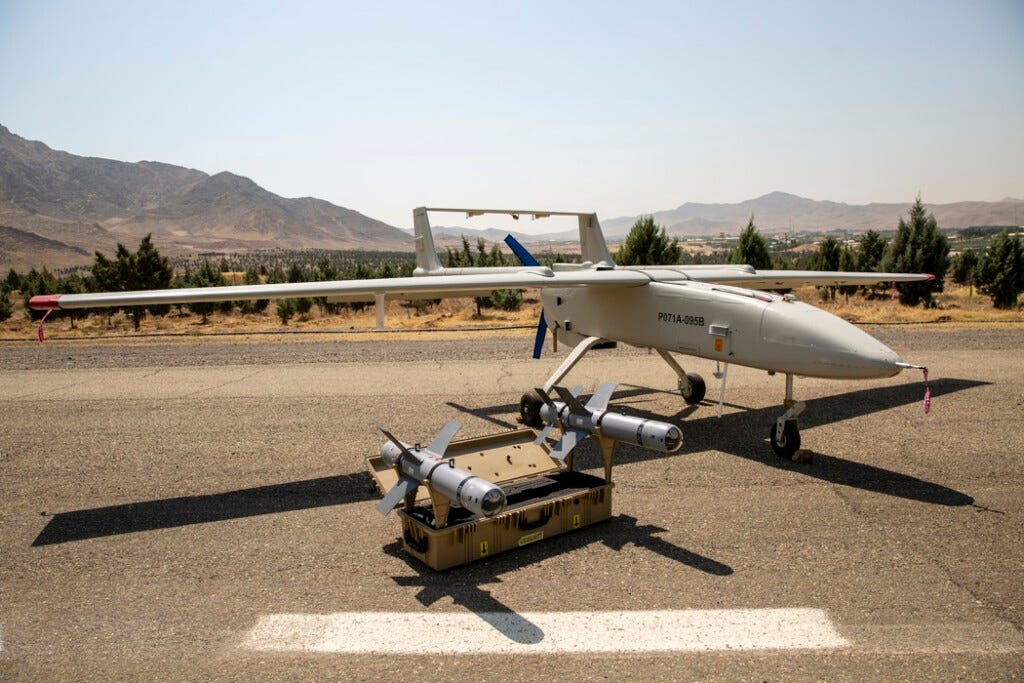Drone barrage hits Port Sudan airport
Growing RSF reliance on unmanned warfare
The Rapid Support Forces (RSF) has launched a drone barrage on Port Sudan International Airport, damaging a military base, critical infrastructure and disrupting key logistical operations. The attack, which occurred at dawn on Sunday, marks the latest in a series of RSF drone assaults aimed at weakening both military and civilian facilities in army-controlled regions.
The drone strike targeted multiple points within the airport compound, including the Osman Digna military airbase, and a cargo terminal. Initial reports indicate substantial damage, though details of casualties remain unclear. This attack follows a pattern of increasing drone strikes by the RSF, which have escalated in frequency and sophistication as part of their ongoing conflict against the Sudanese Armed Forces (SAF), the traditional military that controls Port Sudan.
The use of drones by the RSF signals a new phase in Sudan's conflict, with the paramilitary group increasingly relying on unmanned aerial vehicles (UAVs) to carry out high-impact attacks, targeting northern and eastern regions of Sudan resulting in damage of key infrastructure including the Merowe Dam and the Dongola electricity station, sparking electricity outage across the country.
Sudan War Monitor is a collaborative of journalists and open source researchers tracking the events of Sudan’s war and the search for solutions. We’re building a platform to battle disinformation and warmongering and amplify the voices of victims, humanitarians and peacemakers.
This shift in strategy highlights the RSF’s ability to target hard-to-reach infrastructure and military assets, changing the dynamics of the war where is has recently incurred heavily losses on key territories including the capital region Khartoum where its presence is currently confined to a few neighborhoods in southern and western Omdurman, the capital’s largest city.
Port Sudan has served as the administrative capital of the country following outbreak of war in Khartoum in April 2023, and its airport, which has been a key transit hub for both civilian and military cargo, is now part of the escalating toll of civilian sites caught in the crossfire.
While the RSF did not issue any statement on the attack, the military in a statement posted on its Facebook page said that the attack resulted in “limited damage” including on an ammunition store at the airbase without human casualties.
“On the morning of May 4, 2025, the enemy targeted the Othman Digna Airbase, a cargo warehouse, and several civilian facilities in Port Sudan with suicide drones. Our ground defenses were able to shoot down several of them. Some of the drones caused limited damage, including hitting a munitions storage facility at Othman Digna Airbase, causing scattered explosions. There were no casualties among personnel,” reads the statement reviewed by Sudan War Monitor.
Speaking at the foreign ministry headquarters in Port Sudan during a press conference attended by heads of diplomatic missions following the attack, Sudanese army’s Red Sea military area Mahjoub Bushra put the number of the drones at 11, which he identified kamikaze drones, and targeted key locations including the radar station at Flamingo, the Osman Digna Air Base, and several critical civilian infrastructure sites.
Kamikaze drones, also known as suicide drones or loitering munitions, are unmanned aerial vehicles (UAVs) designed to crash into targets, delivering precision strikes with explosive payloads. They are often used against high-value targets like military infrastructure and vehicles, offering a cost-effective option for both state and non-state actors. These drones have gained attention for their effectiveness in recent conflicts, such as in Ukraine and the Middle East, due to their ability to carry out targeted strikes without risking soldiers’ lives.
Bushra said the military neutralized all the 11 drones, with several downed over the sea due to defensive actions, and seven of them were recovered and are now in military custody. He said that the swarm of kamikaze drones was a tactical distraction to divert attention from a single strategic drone that successfully struck the airport, causing what he described as “some material damage” and “light” human injuries.
“All suicide bombers have been successfully dealt with by the air defense and have been completely neutralized. The number of suicide bombers that have been neutralized is estimated to be 11. A large number of them have fallen into the [Red] sea due to the actions taken by the air defense and seven of these suicide bombers are now in our hands.”
“During the air defense battle with these suicide bombers, the strategic suicide bomber attacked at 4.30 a.m. and caused some material damage to the base. There were no human losses, except for some light injuries among the workers at the base. In fact, the suicide bombers that continued to attack for more than two and a half hours were aimed diverting attention from the main attack by the strategic drone and to disable the air defense from attacking the main strategic suicide bomber. More than 11 suicide bombers were launched at different times to disable the air defense from attacking these suicide bombers,” Bushra said.
Air traffic at Port Sudan Airport was suspended for several hours, indicating a more serious disruption than publicly acknowledged.
Based on Flight Radar data analysis by Sudan War Monitor, within hours of the attack, Redstar Aviation’s Turkish-registered Learjet 45XR air ambulance (reg. TC-RSB) landed at Port Sudan, raising questions about the accuracy of the casualty report.
The arrival of the ICU-equipped aircraft suggests the possible presence of unreported severe injuries requiring urgent evacuation. Osman Digna Airbase, a military installation embedded within the airport, is known to host SAF officers and command personnel, making it a high-value target.
The deployment of the Turkish medevac jet shortly after the strike – despite claims of no significant casualties – implies that senior military figures may have been injured and discreetly evacuated to avoid morale damage.
In a statement, the ministry of foreign affairs condemned the attack, describing it as an act of terrorism. A government spokesperson emphasized that such strikes were part of the RSF's ongoing efforts to destabilize Sudan, calling for international support to contain the escalating violence. The government has pledged to strengthen security in the region and hold those responsible accountable.
“In a blatant insistence on continuing its destructive and subversive approach targeting the Sudanese people and their infrastructure, the terrorist RSF militia launched suicide drones this morning targeting the Osman Digna Air Base in Port Sudan. The attack resulted in damage to several warehouses and civilian service facilities.”
“This attack comes just two days after the criminal militia carried out a similar terrorist airstrike targeting facilities in the city of Kassala. This escalation by the rebel Janjaweed RSF militia and its regional sponsor reaffirms their determination to destroy infrastructure and service facilities essential for providing Sudanese citizens with a dignified life and well-being—a conduct condemned by international norms and laws.”
“While the Ministry strongly condemns and denounces this criminal and terrorist behavior, it reiterates its call to the international community to urgently fulfill its duty in enforcing international laws to compel the terrorist militia to immediately cease these criminal acts targeting the Sudanese people, their stability, and the safety of their service facilities and infrastructure.”
“Furthermore, pressure must be exerted on the regional state sponsoring the terrorist militia to immediately halt its provision of advanced weapons, funding, and criminal planning, which aim to perpetuate chaos and threaten regional and international peace and security, violating all internationally recognized norms and laws upheld by peace-loving nations,” said the foreign ministry statement,” said the statement.
International and regional reactions
After the attack, several international and regional actors, including the African Union, condemned the strike and called for an immediate halt to hostilities and a thorough investigation into the incident.
The African Union described the attack as a “dangerous escalation” in the ongoing conflict between the SAF and the RSF, warning that it poses a direct threat to civilian lives, humanitarian access, and regional stability.
It reiterated its call for an immediate ceasefire and the resumption of political dialogue, urging all parties to uphold international humanitarian law and allow unhindered humanitarian access.
“The African Union strongly condemns this attack, which escalates the conflict and endangers civilian lives and regional peace... We urge the international community to stand in solidarity with Sudan and intensify efforts to restore stability,” the statement said.
Egypt, Sudan’s northern neighbor which has supported the SAF in the war, also condemned the attacks on Port Sudan and Kassala, emphasizing the need to preserve Sudan's resources and avoid targeting critical infrastructure.
“The Arab Republic of Egypt condemns the targeting of infrastructure and vital facilities in the cities of Port Sudan and Kassala... Egypt calls for a ceasefire to protect the Sudanese people’s resources and prevent further damage to civilian infrastructure,” said a statement from the Egyptian foreign ministry, highlighting the detrimental effect on humanitarian aid efforts, stressing that such attacks hinder efforts to deliver assistance to those in need.
Other regional powers, including Iran, Saudi Arabia, and Kuwait, joined the condemnation, emphasizing the urgent need for dialogue to end the conflict, which has claimed tens of thousands of civilian lives and displaced millions both internally and across borders.
These nations reiterated their support for a peaceful resolution to the ongoing violence and stressed the importance of prioritizing dialogue over continued hostilities, which is expected to further escalate humanitarian toll of the conflict.
Sudan War Monitor is a collaborative of journalists and open source researchers tracking the events of Sudan’s war and the search for solutions. We’re building a platform to battle disinformation and warmongering and amplify the voices of victims, humanitarians and peacemakers.
Growing RSF reliance on unmanned warfare
The growing reliance on drones by the RSF marks a sharp turn in the group’s military strategy, one that is deeply rooted in the shifting realities they face after significant setbacks in central and eastern Sudan. Initially, the RSF incorporated suicide drones early in the conflict. However, in recent months, their use has escalated to unprecedented levels, signaling a new phase in their warfare tactics.
The shift toward unmanned aerial vehicles is directly tied to the RSF's struggle on the ground. After heavy losses in Al Jazira and Khartoum states at the during between January and March, the group’s physical presence in central Sudan has significantly dwindled. This has forced the RSF to adapt, and drones have proven to be an effective tool in this new phase of the conflict.
In the face of mounting casualties from direct combat, drones allow the RSF to strike without the need for ground troops, reducing their exposure to risks while still making an impact on critical targets. The strategic advantage they now hold – being able to target cities hundreds of kilometers away – was once beyond their reach, even though they had advanced to the outskirts of some northern and eastern cities earlier in the war.
For the group, this technological shift isn’t just about keeping up with modern trends in warfare; it’s a tactical response to necessity. As the RSF has been pushed back in key regions, drones offer a way to carry on the fight without the need for sustained ground engagements.
The group’s most recent operations, including strikes on the Merowe Dam and Dongola’s electricity station, have caused widespread power outages in major cities such as Khartoum and Port Sudan. These attacks go beyond mere tactical strikes – they reflect the RSF’s broader strategy to disrupt Sudan’s already fragile infrastructure.
Beyond the immediate damage caused by these strikes within Sudan, the RSF’s shift to drone warfare carries significant regional implications. African analyst and former U.S. diplomat Cameron Hudson has argued that this new reliance on drones is part of a wider pattern of regional instability, with the RSF now capable of extending its reach beyond Sudan’s borders.
Hudson describes the situation as a “fundamentally new war,” drawing a comparison to the ongoing conflict in Ukraine, where drones have become a key element in asymmetrical warfare. In his view, Sudan is now a full-scale drone war zone, with no corner of the country safe from RSF attacks, which are increasingly supported by the UAE.
“This is a fundamentally new war. Sudan is now Ukraine. A full-blown drone war on the Red Sea with no corner of Sudan safe from UAE-backed RSF terror attacks. No returns, no rebuilding, no reconciliation can possibly occur with drone threats ever-present,” Hudson said in a post on X (formerly Twitter).
Hudson went on to highlight the growing regional impact, warning that the regional war could soon spread, with strikes on targets in Chad, South Sudan, and the Central African Republic becoming increasingly likely.
Videos
The following videos filmed by residents of Port Sudan and Eye Witnesses capture moments of the attack as flames and fire rages at an ammo store at the Port Sudan Airport.
Video 1:
Video 2:
Video 3:
Support our journalism
Thank you for reading Sudan War Monitor. We do this work because we believe that journalism is one accountability mechanism that ultimately can contribute toward peace and justice in Sudan—however distant that hope may be. Our work is intended to be a resource for humanitarians, civil society, ordinary Sudanese, diplomats, and news media. Subscribe or share to support our work and help “Keep Eyes on Sudan.”








I would be very interested to read an article that explains clearly what this dreadful war is all about; i.e., who supports each side and why. Why is the UAE sending drones to the side that appears even worse than the other? How is Russia involved? Egypt? Does China have a role? Is the US just a callous bystander? I’m sure there is writing out there that makes clear what is at stake here, which I just happen to have missed. Recommendations, anyone?